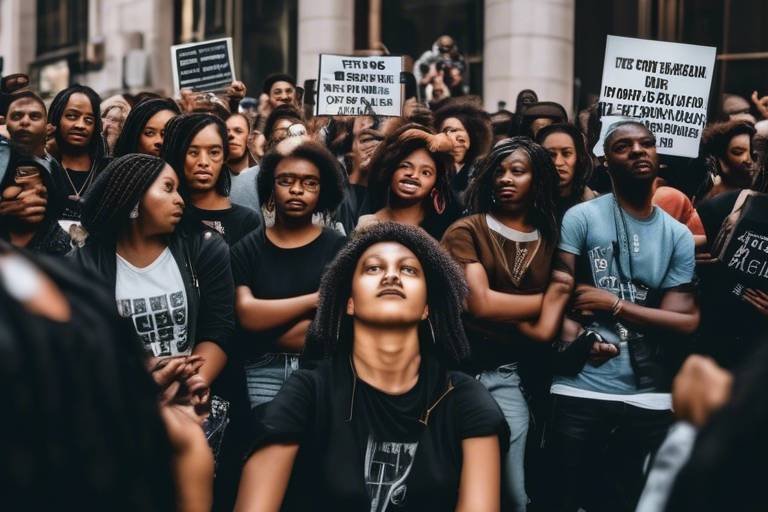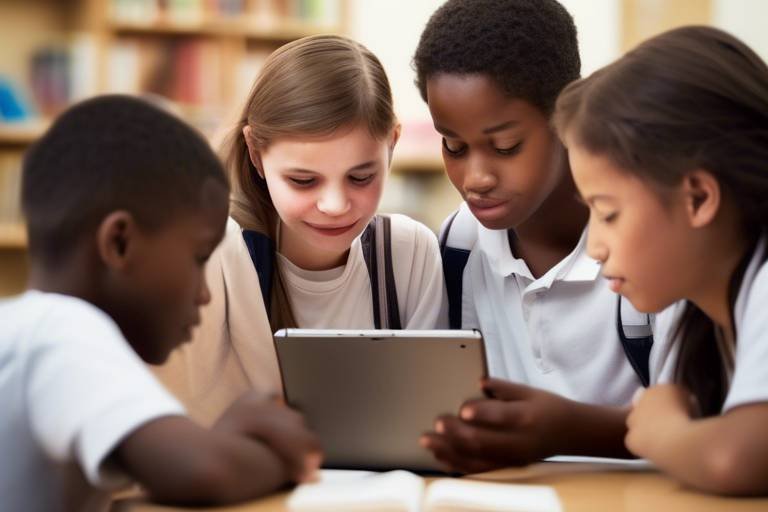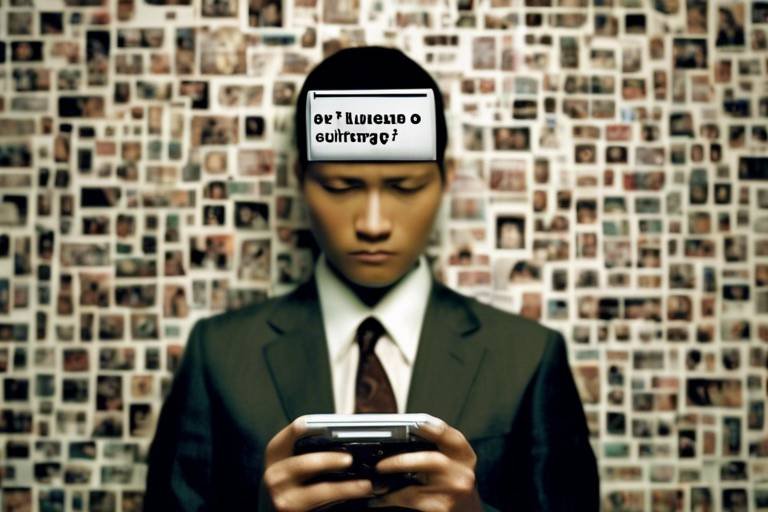The Role of Social Media in Crisis Awareness
In today's fast-paced digital world, social media has become an integral part of our lives, serving not just as a platform for sharing memes and vacation photos, but as a vital tool for disseminating information during crises. Imagine being in a situation where every second counts, and the right information can make all the difference between safety and danger. This is where social media platforms step in, acting as a lifeline for communities and organizations alike. The ability to share updates, seek help, and coordinate responses in real-time transforms how we manage crises, ensuring that awareness spreads like wildfire, reaching those who need it most.
Social media's role in crisis awareness goes beyond mere communication; it embodies a sense of community and collective action. When disasters strike, people often turn to their social networks for support, information, and guidance. This interconnectedness fosters a culture of sharing and solidarity, allowing individuals to not only receive updates but also to contribute to the conversation. The ripple effect of a single post can mobilize resources, connect volunteers, and even save lives. Thus, understanding how social media operates during crises is crucial for both individuals and organizations aiming to navigate these challenging times effectively.
As we delve deeper into the mechanics of crisis communication, it becomes evident that each social media platform brings its own unique strengths to the table. From the rapid-fire updates of Twitter to the community-building capabilities of Facebook, these platforms cater to different aspects of crisis awareness. They serve as hubs for information exchange, enabling users to stay informed and engaged. Moreover, with the rise of mobile technology, accessing these platforms has never been easier, allowing information to flow seamlessly, regardless of geographical barriers.
However, while social media has proven to be an invaluable resource during crises, it is not without its challenges. The very nature of these platforms can sometimes lead to the spread of misinformation, which can exacerbate panic and confusion. Therefore, it is essential to approach information shared on social media with a critical eye, verifying facts before sharing them further. The digital divide also poses a significant challenge, as not everyone has equal access to technology and the internet. This disparity can leave vulnerable populations at a disadvantage during emergencies, highlighting the need for inclusive communication strategies.
In summary, social media platforms play a crucial role in enhancing crisis awareness and facilitating communication among communities and organizations. By harnessing the power of these tools, we can create a more informed and responsive society, ready to tackle the challenges that arise during crises. As we continue to explore the various dimensions of crisis communication, it becomes clear that the potential for social media to effect positive change is immense, provided we navigate its complexities with care and responsibility.
- How does social media help during a crisis? Social media helps disseminate information quickly, connect individuals with resources, and facilitate community support.
- What are the risks of using social media in crisis situations? The primary risks include the spread of misinformation, potential for panic, and unequal access to information due to the digital divide.
- Which social media platforms are most effective during crises? Platforms like Twitter, Facebook, and Instagram each have unique strengths, such as real-time updates on Twitter and community engagement on Facebook.

Understanding Crisis Communication
Effective crisis communication is not just a necessity; it’s a lifeline in times of turmoil. When a crisis hits—whether it's a natural disaster, a public health emergency, or a corporate scandal—the way information is conveyed can mean the difference between chaos and calm. In today’s fast-paced digital landscape, where news travels at lightning speed, understanding the principles of crisis communication is more important than ever. It’s not merely about sending out a message; it’s about crafting a narrative that resonates, reassures, and informs.
At the heart of crisis communication lies the principle of transparency. Audiences are more likely to trust organizations that are open about what they know and don’t know. This honesty fosters credibility, which is crucial during a crisis when misinformation can spread like wildfire. Additionally, the principle of timeliness cannot be overstated. In a world where seconds count, delivering information promptly can help mitigate panic and guide individuals towards safety. Think of it like trying to catch a train; if you miss the moment to board, you might find yourself left behind, and the same goes for communicating during a crisis.
Moreover, effective crisis communication should be audience-centric. It’s not just about what you want to say; it’s about what your audience needs to hear. This means tailoring your messages to different groups—be it the general public, stakeholders, or media outlets. Each audience may require different types of information or levels of detail. For instance, first responders need actionable, detailed information, while the general public may benefit from broader safety tips and reassurance.
A crucial component of crisis communication is the use of various channels to disseminate information. Relying solely on one medium can lead to gaps in communication. For example, while traditional media like television and radio play significant roles, social media platforms have emerged as powerful tools for reaching wider audiences quickly. The integration of multiple channels ensures that messages are not only received but also understood.
In summary, effective crisis communication hinges on transparency, timeliness, audience-centric messaging, and the strategic use of various communication channels. By adhering to these principles, organizations can navigate the stormy seas of a crisis with greater agility and confidence, ultimately safeguarding public trust and ensuring safety.

Social Media Platforms Overview
In today's fast-paced world, social media has become an indispensable tool for crisis awareness. Each platform offers unique features that cater to different needs during emergencies. Understanding how these platforms operate can significantly enhance our ability to communicate effectively during crises. Let's delve into the characteristics of major social media platforms, such as Twitter, Facebook, and Instagram, and explore how they contribute to disseminating vital information.
Twitter is often the first place people turn to for real-time updates. Its character limit forces users to be concise, making it a powerful medium for urgent messages. The immediacy of tweets allows for rapid dissemination of information, which is crucial during a crisis. For instance, during natural disasters, authorities can quickly share evacuation routes or safety tips, ensuring that the public remains informed.
Facebook, on the other hand, excels in fostering community engagement. Through groups and pages dedicated to specific crises, individuals can share their experiences, offer support, and seek assistance. This platform allows for longer-form content, enabling organizations to provide detailed updates and resources. Facebook’s event feature can also be utilized to organize community meetings or relief efforts, bringing people together in a time of need.
Instagram is visually driven, making it an effective platform for sharing images and videos that convey the emotional weight of a crisis. During events like wildfires or floods, powerful visuals can evoke empathy and prompt action from viewers. Instagram Stories and Reels allow for quick updates that can reach a broad audience, making it an essential tool for organizations trying to raise awareness and mobilize support.
To summarize, here’s a quick comparison of these platforms:
| Platform | Strengths | Best Use Cases |
|---|---|---|
| Real-time updates, concise messaging | Urgent alerts, breaking news | |
| Community engagement, detailed information | Support groups, resource sharing | |
| Visual storytelling, emotional impact | Awareness campaigns, fundraising |
In conclusion, the diverse functionalities of social media platforms allow them to play a pivotal role in crisis awareness. By leveraging the strengths of each platform, organizations and individuals can enhance communication and ensure that vital information reaches those who need it most. As we continue to navigate an increasingly digital landscape, understanding these platforms will empower us to respond effectively in times of crisis.
- How can I use social media during a crisis? Utilize platforms like Twitter for immediate updates, Facebook for community support, and Instagram for visual storytelling to share your message effectively.
- What should I do if I encounter misinformation on social media? Report the misinformation, share accurate information from credible sources, and encourage others to verify facts before sharing.
- Are there any risks associated with using social media in crises? Yes, misinformation and panic can spread quickly, so it’s crucial to communicate responsibly and verify facts before sharing.

The Impact of Twitter
Twitter has emerged as a powerhouse in the realm of crisis communication, primarily due to its unique features that cater to the need for real-time updates. Imagine being in a situation where every second counts—whether it's a natural disaster, a public health emergency, or any urgent situation. Twitter's 280-character limit encourages users to distill complex information into concise, digestible bites. This brevity means that important messages can be shared quickly, allowing users to stay informed without wading through lengthy posts.
One of the standout features of Twitter is its ability to create a sense of urgency and immediacy. When a crisis occurs, users can turn to Twitter for the latest updates, often before traditional media outlets can report on the situation. This immediacy is crucial; for instance, during events like hurricanes or wildfires, people can follow live updates from local authorities, emergency services, and even fellow citizens who are on the ground. The platform acts as a virtual town square, where information flows freely and rapidly.
Furthermore, Twitter’s global reach cannot be overlooked. A tweet sent from one corner of the world can be seen by millions within moments. This characteristic is particularly beneficial during international crises, where information needs to transcend borders. For example, during the COVID-19 pandemic, Twitter became a vital source of information on health guidelines, safety protocols, and vaccination updates. The platform allowed health organizations and governments to disseminate crucial information quickly, reaching diverse audiences across the globe.
Another critical aspect of Twitter's impact on crisis awareness is the use of hashtags. These simple tags can transform a single tweet into part of a larger conversation. When a crisis occurs, specific hashtags often emerge, allowing users to follow discussions and updates related to that event easily. For instance, during natural disasters, hashtags like #HurricanePrep or #WildfireAlert can help aggregate all relevant information in one place, making it easier for individuals to find assistance, share resources, or offer support.
Hashtags serve as a powerful tool for organizing information during crises. They not only help in categorizing tweets but also in amplifying critical messages. When a hashtag trends, it signifies that a large number of users are discussing a particular topic, drawing more attention to it. This phenomenon can be particularly beneficial in crisis situations, where the visibility of accurate information is paramount. For example, during the 2011 earthquake and tsunami in Japan, hashtags like #PrayForJapan helped mobilize international support and resources, showcasing how Twitter can be a catalyst for community action.
To illustrate Twitter's effectiveness in crisis situations, let’s look at a couple of notable examples:
- Hurricane Harvey (2017): During this catastrophic event, Twitter was flooded with real-time updates from rescue teams, citizens needing help, and organizations offering support. The hashtag #HarveyRescue became a lifeline for many.
- COVID-19 Pandemic: Health organizations utilized Twitter to share updates on the virus, safety measures, and vaccination information. The hashtag #COVID19 became a central hub for information dissemination, connecting millions globally.
These examples underscore the profound impact Twitter can have during crises. It not only facilitates the rapid spread of information but also fosters a sense of community among those affected. In a world where misinformation can spread just as quickly, the ability to share verified information in real-time is invaluable. As we continue to navigate an increasingly digital landscape, the role of Twitter in crisis awareness will only become more pronounced, making it an essential tool for communication and community resilience.

Hashtags and Trends
In the fast-paced world of social media, hashtags have emerged as powerful tools for organizing and amplifying information, especially during crises. When an event occurs that demands immediate attention, the use of a specific hashtag can unify voices and streamline communication. For instance, during natural disasters or public health emergencies, hashtags like #HurricanePreparedness or #COVID19Updates can serve as a beacon for individuals seeking reliable information. These hashtags not only categorize posts but also create a sense of community among users who are navigating similar challenges.
One of the most remarkable aspects of hashtags is their ability to transform into trending topics. When a hashtag gains enough traction, it trends on platforms like Twitter, which can significantly increase its visibility. This phenomenon can lead to a surge in public awareness and engagement. For example, during the 2020 Australian bushfires, the hashtag #AustraliaFires trended globally, drawing attention to the crisis and prompting international support. The collective action fueled by trending hashtags can mobilize resources, raise funds, and even influence policy changes.
However, while hashtags can be a force for good, they also come with challenges. The very nature of social media means that information can spread rapidly, but not all of it is accurate. In moments of crisis, misinformation can easily infiltrate the conversation, leading to confusion and panic. Therefore, it’s crucial for users to critically evaluate the sources of information associated with trending hashtags. By following reputable accounts and cross-referencing facts, individuals can better navigate the flood of information that often accompanies crises.
Moreover, the effectiveness of hashtags is not universal; it varies based on demographics and access to technology. For some communities, particularly those with limited internet access, the power of hashtags may not reach them. This highlights the importance of inclusive communication strategies that ensure everyone is informed, regardless of their social media engagement levels.
In summary, hashtags and trends play a pivotal role in crisis awareness. They serve as tools for information dissemination, community building, and mobilization. However, their impact can be mitigated by the challenges of misinformation and unequal access. As we continue to navigate the complexities of social media during crises, understanding the dynamics of hashtags can empower individuals and organizations to respond more effectively.
- What is the purpose of hashtags during a crisis?
Hashtags help categorize information, make it easier to find, and connect individuals facing similar challenges. - How can I ensure the information I find through hashtags is accurate?
Always check the credibility of the sources, follow reputable accounts, and cross-reference information with reliable news outlets. - Can hashtags influence public policy?
Yes, trending hashtags can draw significant attention to issues, prompting discussions and potentially influencing decision-makers. - What challenges do hashtags face in crisis communication?
Misinformation can spread quickly, and not all communities have equal access to social media platforms, which can hinder effective communication.

Case Studies on Twitter Usage
Twitter has proven to be an indispensable tool in crisis situations, providing a platform for real-time communication and information sharing. One of the most notable examples is the use of Twitter during natural disasters, such as hurricanes and earthquakes. For instance, during Hurricane Harvey in 2017, Twitter became a lifeline for many residents in Texas. Users shared urgent updates, safety information, and rescue requests, creating a virtual community that transcended geographical barriers. The immediacy of tweets allowed for rapid dissemination of critical information, enabling those in affected areas to make informed decisions quickly.
Another compelling case study is the 2010 earthquake in Haiti. In the aftermath of the disaster, Twitter emerged as a crucial channel for both local and international organizations. Humanitarian groups used the platform to coordinate relief efforts, while individuals shared their experiences and needs. The hashtag #Haiti became a rallying point, uniting people across the globe who wanted to help. This event showcased how Twitter could mobilize support and resources in real time, illustrating its potential to enhance crisis awareness and response.
Moreover, during the COVID-19 pandemic, Twitter played a significant role in disseminating information about safety protocols, vaccine availability, and public health guidelines. Health organizations and government officials utilized the platform to reach vast audiences quickly. For example, the World Health Organization (WHO) launched the hashtag #COVID19 to provide updates and combat misinformation. This initiative not only informed the public but also encouraged users to share accurate information, demonstrating the power of collective action on social media.
In addition to these examples, various studies have highlighted the effectiveness of Twitter in crisis situations. A recent analysis of Twitter usage during crises found that tweets containing hashtags related to emergencies were significantly more likely to be retweeted, amplifying their reach. This amplification is crucial, as it allows critical messages to reach individuals who may not be following official accounts but are still in need of information. The table below summarizes key findings from research on Twitter's impact during crises:
| Case Study | Year | Key Findings |
|---|---|---|
| Hurricane Harvey | 2017 | Real-time updates on safety and rescue operations. |
| Haiti Earthquake | 2010 | Coordination of international relief efforts through hashtags. |
| COVID-19 Pandemic | 2020 | Spread of accurate health information and combatting misinformation. |
These case studies not only illustrate the power of Twitter in crisis situations but also highlight the platform's ability to foster community engagement and support. As we continue to navigate an increasingly digital world, the lessons learned from these instances can inform future strategies for crisis communication. The immediacy and reach of Twitter make it a vital component of modern crisis management, enabling individuals and organizations to respond effectively in times of need.
Q1: How can I use Twitter during a crisis?
A1: During a crisis, you can use Twitter to follow official accounts for real-time updates, share your location if you're in need of help, and use relevant hashtags to connect with others in the community.
Q2: What should I do if I see misinformation on Twitter?
A2: If you encounter misinformation, it's best to verify the information through trusted sources before sharing it. You can also report the tweet or reply with accurate information to help clarify the situation.
Q3: Can Twitter help in non-natural crises?
A3: Absolutely! Twitter can be instrumental during various crises, including public health emergencies, political unrest, and social movements, by facilitating communication and mobilizing support.

The Role of Facebook
Facebook has emerged as a crucial platform for community engagement during crises, offering unique features that facilitate information sharing and support among affected individuals. Unlike other social media networks, Facebook provides a more personal touch, allowing users to connect with friends, family, and local communities in times of need. During a crisis, this sense of community can be invaluable, as it fosters a support system that can help individuals cope with the challenges they face.
One of the standout features of Facebook is its ability to create dedicated groups and pages that can serve as hubs for information dissemination. For instance, during natural disasters like hurricanes or wildfires, local residents often turn to Facebook to share real-time updates, safety tips, and resources. These groups can quickly become lifelines for those affected, as they provide a space for individuals to ask questions, offer assistance, and share their experiences. Moreover, Facebook's event feature allows organizations to coordinate relief efforts, making it easier for volunteers to come together and support those in need.
Additionally, Facebook Live has revolutionized how information is shared during crises. Organizations and individuals can broadcast live updates, providing real-time information that can help keep people safe. This immediacy is crucial, especially in situations where every second counts. For example, during a severe weather event, local authorities can use Facebook Live to inform residents about evacuation orders, road closures, and safety precautions. This direct line of communication helps to cut through the noise of misinformation that can often circulate on the platform.
However, while Facebook plays a significant role in crisis awareness, it is not without its challenges. The platform's vast user base can lead to the rapid spread of misinformation, which can complicate crisis management efforts. To combat this, Facebook has implemented measures to flag false information and promote verified sources. Nonetheless, users must remain vigilant and critical of the information they encounter, ensuring they rely on credible sources for their updates.
In summary, Facebook serves as a vital tool for crisis awareness and community support. Its unique features enable individuals and organizations to connect, share information, and mobilize resources effectively. While challenges such as misinformation exist, the platform's ability to foster community engagement and provide real-time updates makes it an indispensable resource during crises.
- How does Facebook help during a crisis? Facebook allows users to share real-time updates, create support groups, and coordinate relief efforts, making it easier for communities to come together in times of need.
- What features of Facebook are most useful in crises? Key features include Facebook Groups, Pages, and Facebook Live, which facilitate information sharing and community support.
- What challenges does Facebook face during crises? The spread of misinformation is a significant challenge, as false information can complicate crisis management efforts.
- How can users ensure they are getting accurate information on Facebook? Users should verify information through credible sources and be cautious of sensationalized posts.

Challenges and Limitations
While social media serves as a powerful tool for enhancing crisis awareness, it is not without its . One of the primary issues that arises during crises is the rapid spread of misinformation. In the heat of the moment, when emotions run high and information is desperately sought, false information can circulate just as quickly—if not quicker—than verified facts. This can lead to confusion, panic, and even dangerous situations. For instance, during natural disasters, inaccurate reports about evacuation routes or safety measures can put lives at risk. Therefore, the challenge lies not only in disseminating accurate information but also in ensuring that the public can distinguish between what is true and what is not.
Moreover, the phenomenon known as the digital divide presents another significant hurdle. Not everyone has equal access to social media platforms. Factors such as socioeconomic status, geographic location, and age can all influence an individual’s ability to receive timely updates during crises. For example, rural areas may have limited internet connectivity, leaving residents uninformed about critical developments. This disparity can exacerbate existing inequalities, as those without access may find themselves at a greater disadvantage during emergencies.
Additionally, the potential for panic and misinformation during crises cannot be overlooked. When people encounter alarming posts or sensational headlines, their instinctive reaction may be to share that information without verifying its accuracy. This can lead to a cascade effect, where the original post is amplified, resulting in widespread panic. It is essential for organizations and individuals to promote media literacy and encourage critical thinking about the information shared on social media. By fostering a culture of verification, we can help mitigate the risks associated with rapid information dissemination.
To illustrate these challenges, consider the following table that summarizes some of the key issues associated with social media in crisis awareness:
| Challenge | Description |
|---|---|
| Misinformation | False information spreads quickly, complicating crisis management. |
| Digital Divide | Not everyone has equal access to social media, leading to unequal information dissemination. |
| Panic | Alarming posts can incite fear, resulting in hasty sharing of unverified information. |
In conclusion, while social media has revolutionized crisis communication by providing immediate access to information, it is crucial to remain vigilant about its challenges. By addressing misinformation, bridging the digital divide, and promoting responsible sharing practices, we can harness the full potential of social media to enhance awareness and facilitate effective responses during crises.
1. What is the biggest challenge of using social media during a crisis?
The biggest challenge is the rapid spread of misinformation, which can lead to confusion and panic among the public.
2. How does the digital divide affect crisis awareness?
The digital divide means that not everyone has equal access to social media, resulting in some individuals being uninformed during critical situations.
3. What can be done to combat misinformation on social media?
Promoting media literacy and encouraging individuals to verify information before sharing can help combat misinformation.

Misinformation and Its Effects
Misinformation can spread like wildfire on social media, especially during crises when emotions run high and information is desperately sought. In a world where a single tweet can reach millions within seconds, the potential for misleading information to circulate is significant. This phenomenon not only complicates crisis management but can also lead to severe consequences, such as panic, confusion, and even harm to individuals or communities. Imagine a community facing a natural disaster; if false information about evacuation routes or safety measures spreads, it could endanger lives.
To illustrate the impact of misinformation, consider the following effects:
- Public Panic: Incorrect information can incite fear and panic among the public, leading to irrational behavior. For example, during a health crisis, rumors about a disease's transmission can cause people to overreact, potentially overwhelming healthcare systems.
- Loss of Trust: When false information is revealed, it can erode trust in official sources and authorities. This loss of credibility can hinder effective communication in future crises, as people may become skeptical of legitimate updates.
- Resource Misallocation: Misinformation can lead to resources being directed to areas that do not require them, leaving those in genuine need without adequate support. For instance, during a flood, if incorrect information suggests a different area is at risk, aid may be misallocated.
To combat misinformation effectively, it is crucial to implement several strategies:
- Verification Processes: Encourage users to verify information before sharing it. This could involve checking with credible news sources or official announcements.
- Education and Awareness: Promote media literacy programs that teach individuals how to discern reliable information from falsehoods. Understanding the difference can empower communities to resist the spread of misinformation.
- Real-time Monitoring: Utilize technology to monitor social media platforms for false narratives. By identifying and addressing misinformation promptly, authorities can mitigate its effects.
In conclusion, while social media is a powerful tool for crisis communication, the spread of misinformation poses a significant challenge. It is essential for individuals, organizations, and authorities to work collaboratively to ensure that accurate information prevails, thus safeguarding communities during critical times.
Q1: What is misinformation?
A1: Misinformation refers to false or misleading information that is spread, regardless of intent. It can arise from misunderstandings, misinterpretations, or outright fabrication.
Q2: How can I verify information on social media?
A2: To verify information, check reputable news sources, look for official statements from authorities, and use fact-checking websites that specialize in debunking false claims.
Q3: What can I do if I encounter misinformation?
A3: If you encounter misinformation, refrain from sharing it. Instead, report it to the platform and share accurate information from credible sources to help counteract the false narrative.
Q4: Why is misinformation particularly dangerous during crises?
A4: During crises, people are often in a heightened state of anxiety and urgency, making them more susceptible to believing and spreading misinformation, which can lead to panic and poor decision-making.

Digital Divide Considerations
The concept of the digital divide refers to the gap between those who have easy access to digital technology and the internet, and those who do not. In the context of crisis awareness, this divide can have serious implications. Imagine a community facing a natural disaster; those without internet access may find themselves cut off from vital information that could save lives. This lack of access can hinder effective communication, making it challenging for emergency services to reach everyone in need.
Furthermore, the digital divide isn't just about access; it also encompasses digital literacy. Even in areas where internet access is available, individuals may lack the skills to navigate social media platforms effectively. This can lead to a situation where information is available, but not everyone knows how to find or interpret it. During crises, when time is of the essence, this can lead to confusion and misinformation spreading like wildfire.
To illustrate the impact of the digital divide on crisis awareness, consider the following factors:
- Geographic Disparities: Rural areas often have less reliable internet access compared to urban centers. This can leave rural communities vulnerable during crises, as they may not receive timely updates or alerts.
- Socioeconomic Factors: Individuals from lower-income backgrounds may struggle to afford devices or data plans. This economic barrier can prevent them from accessing critical information during emergencies.
- Age and Education: Older adults may not be as familiar with social media platforms, making it harder for them to receive alerts or guidance during a crisis.
Addressing the digital divide is not just about providing access to technology; it’s about ensuring that all members of a community are equipped to use it effectively. This means investing in community training programs that teach digital skills, as well as ensuring that infrastructure is in place to provide reliable internet access to underserved areas. Without these efforts, we risk leaving vulnerable populations in the dark during critical situations.
As we continue to rely on social media for crisis communication, it’s essential to recognize and address these disparities. Only then can we create a more inclusive environment where everyone has the opportunity to stay informed and safe during emergencies.
- What is the digital divide? The digital divide refers to the gap between those with easy access to digital technology and the internet and those without.
- How does the digital divide affect crisis awareness? It limits access to crucial information during emergencies, particularly for vulnerable populations.
- What can be done to bridge the digital divide? Investing in infrastructure, providing affordable internet access, and offering digital literacy training can help bridge this gap.
Frequently Asked Questions
- How does social media enhance crisis awareness?
Social media enhances crisis awareness by providing real-time updates and facilitating communication among users. Platforms like Twitter, Facebook, and Instagram allow individuals and organizations to share urgent information quickly, ensuring that communities stay informed and connected during emergencies.
- What role do hashtags play in crisis communication?
Hashtags are essential in organizing information during crises. They help categorize posts, making it easier for users to find relevant updates and resources. Trending hashtags can amplify critical messages, allowing individuals to access assistance and share their experiences more effectively.
- Can social media spread misinformation during crises?
Yes, social media can spread misinformation rapidly, complicating crisis management efforts. False information can lead to panic and confusion, making it crucial for users to verify sources and rely on trusted organizations for accurate updates. Strategies to combat misinformation include promoting media literacy and encouraging critical thinking among users.
- How does the digital divide affect crisis response?
The digital divide can significantly impact crisis response by limiting access to social media for certain populations. Communities without reliable internet access may miss critical updates, hindering their ability to respond effectively. Addressing this issue requires efforts to improve digital access and ensure that all individuals can receive timely information during crises.
- What are some examples of effective social media use during crises?
There are numerous examples of effective social media use during crises. For instance, during natural disasters, organizations have utilized Twitter to share evacuation routes and safety tips. Similarly, Facebook groups have provided a space for community members to offer support and share resources, showcasing the power of social media in fostering resilience.



















